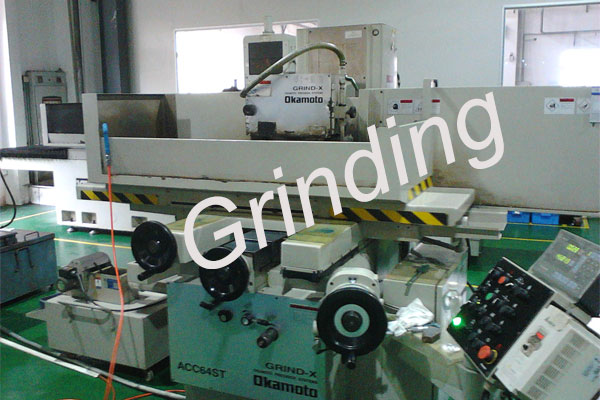What is Grinding?
Jul 15,2020
Classification of a grinding process
Grinding refers to the method of removing the workpiece material with abrasive.According to different requirements and process purposes, grinding has developed into a variety of forms of processing technology, its application is quite extensive.The grinding referred to in this paper mainly refers to grinding with a grinding wheel.The purpose of grinding wheel is: to process the blank into a certain size and shape of semi-finishing and finishing.It is a variety of metal materials, hardened steel,tungsten steel and a variety of high-hardness, high-strength refractory alloy materials processing means, but also processing ceramics,optical glass,rubber, wood and other non-metallic materials processing means.
Generally speaking, according to the processing object to cent, can be divided into outer circle grinding, inner circle grinding, surface grinding and shape grinding.In this paper, the following are surface grinding.
Grinding features
Grinding, refers to the use of abrasive tools, abrasive grains for processing, compared with the car, milling processing, has the following characteristics:
1.There are a large number of cutting edges (abrasive particles) on the surface of the grinding wheel. Their shape, size and distribution are in an irregular and random state.
2.The chip thickness of each grinding grain is very thin, generally only a few microns, so the machining surface can obtain high precision and very low surface roughness.General surface roughness can reach Ra0.08~0.05 micron, precision grinding can reach higher, so grinding is commonly used in the finishing process.
3.The abrasive particles have certain brittleness.The abrasive grain will break and fall under the action of grinding force and heat to renew its cutting edge. This property is called "self-sharpness of the grinding wheel".
4.High grinding efficiency.Generally, the grinding speed of the grinding wheel is about 35m/s, which is more than 20 times that of the ordinary tool, so a high metal cutting rate can be obtained.At the same time, the abrasive particles and the workpiece surface produce strong friction and sharp plastic deformation, so a lot of grinding heat.
5.grinding wheel high hardness, good thermal stability, not only can grind steel, cast iron, copper, aluminum and other materials, but also can grind a variety of high hardness materials, such as hardened steel, hard alloy, glass, ceramics, stone, etc.But the high hardness material USES the general turning, milling and so on traditional processing method is very difficult to process.
Grinding process
During grinding, friction and cutting deformation occur between the grinding wheel and the workpiece, and equal and opposite forces are exerted on the grinding wheel and the workpiece, which are called grinding forces.
In the grinding process, the formation of chips can be divided into three stages:
Stage 1: The abrasive particles contact the surface of the workpiece, the abrasive particles do not enter into the workpiece but only produce friction on the surface, and the surface of the workpiece produces thermal stress.This stage is called the elastic deformation stage.
Stage 2: With the increase of grinding particles cutting into the workpiece, the grinding particles gradually cut into the workpiece, so that the part of the material to both sides uplift, the workpiece surface nicks.This stage is called the delineation stage.
Stage 3: At this time, the abrasive particles have cut into a certain depth and the temperature at the cut has reached a certain level. This part of the material slides along the shear plane and forms chip flying out, generating thermal stress and deformation stress on the surface of the workpiece.This stage is called the cutting stage.
In the grinding process, some sharp grains protrude on the surface of the grinding wheel, and the material of certain thickness is cut off under the action of extrusion friction.The blunt abrasive particles only play the role of surface marking.A convex, low, passivated abrasive particle, or the rear of two adjacent abrasive particles, produces only friction.The chips cut from the abrasive particles are generally very fine (except for heavy load grinding), generally divided into banded chips, fragmental chips and fused spherical chips.Due to high cutting speed, grinding wheel passivation and other reasons, the grinding wheel and the workpiece contact produces a lot of heat, among which 80% of the incoming workpiece, chip away 4%~8%, grinding wheel away 10%~16%, in addition, some part in the form of conduction and radiation.(Conduction to the worktable and fixture, radiation to the air.)When the surface temperature of workpiece is very high, burn and thermal deformation will occur on the surface, which will affect the quality and precision of the surface.So in the grinding process, cooling the workpiece is an important link to ensure the grinding quality.

In the vicinity of the grinding zone, the temperature varies greatly, and there are generally the following distinctions:
Grinding point temperature: the temperature of the grinding edge and the workpiece, chip contact point, is the highest temperature in grinding, instant up to 1000 degrees Celsius above.This temperature not only affects the surface quality, but also the abrasion, breakage, chip adhesion to abrasive particles and the blockage of pore of grinding wheel.
Grinding zone temperature: refers to the average temperature of the grinding wheel and the workpiece contact area, generally about 500~800 degrees Celsius, this temperature affects the grinding surface residual stress, burns and cracks.
Average temperature of workpiece: heat is introduced into the workpiece, is the overall temperature rise of the workpiece, generally only ten degrees, this temperature directly affects the shape and size of the workpiece precision.
Usually we say the grinding temperature refers to the grinding zone temperature.In order to reduce the grinding temperature, the burn and crack on the workpiece surface should be reduced by selecting the grinding wheel and grinding quantity reasonably and reducing grinding depth.Select the grinding wheel correctly, select the coarser grain size, reduce the hardness of the grinding wheel and timely dressing the grinding wheel;Proper selection of coolant or grinding fluid, etc.
Advantages: high precision plane, Angle, groove, boss, outer circle, segment difference, C Angle, arc.
Disadvantages: can't process special-shaped or curved workpiece

